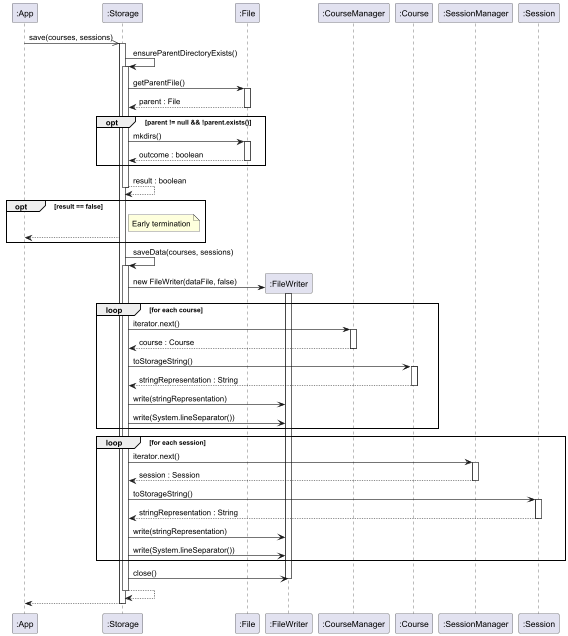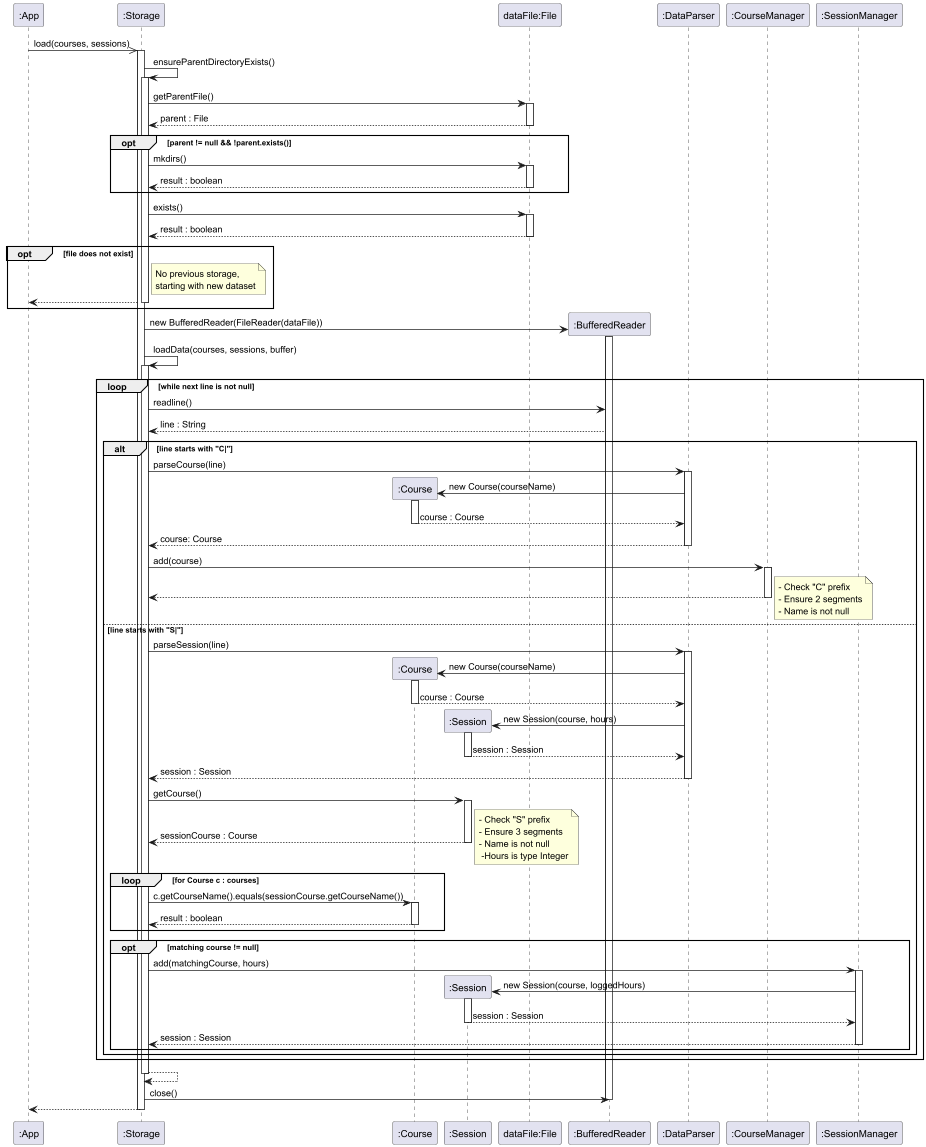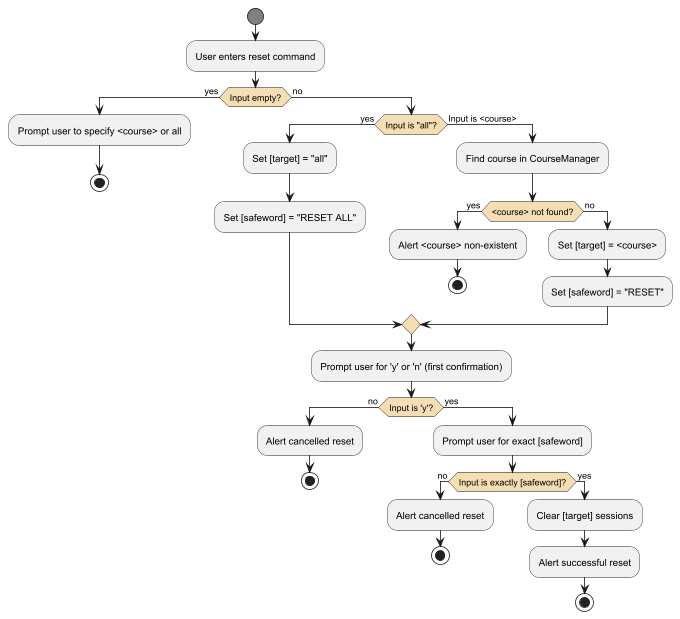tp
Developer Guide
Acknowledgements
{list here sources of all reused/adapted ideas, code, documentation, and third-party libraries – include links to the original source as well}
Design & implementation
Storage Component
Overview
The Storage class is responsible for managing the saving and loading of Course and Study Session to and from the
local machine. NUStudy will load the saved data from the saved txt file if present when starting the application, and
saving all data back to the saved txt file when application exits.
Implementation Details
The Storage component consists of the following key classes:
Storage- Main class that handles file I/O operations for saving and loading dataCourse- Represent a course with a name, provides serialisation viatoStorageString()Session- Represents a study session linked to a course with logged hours, provides serialisation viatoStorageString()CourseManager- Manages the collection of coursesSessionManager- Manages the collection of study sessions
The class diagram below illustrates the relationships between these classes:

File format and conventions
Storage creates a NUStudy.txt in the directory ./data when the application first run and performs a save
operation. Subsequent runs of the application will load data from this file.
The storage file is lined-based, with each line representing a single record:
Format
C|<courseName>
S|<courseName>|<loggedHours>
Where:
C|prefix denotes a Course recordS|prefix denotes a Session record- Fields are separated by the pipe character
| <courseName>is the course identifier<loggedHours>is an integer representing study hours
Examples
C|CS2113
C|MA1508E
S|CS2113|2
S|CS2113|5
S|MA1508E|6
This example shows:
- Two courses: CS2113 and MA1508E
- Three study sessions: two for CS2113 (2 hours and 5 hours) and one for MA1508E (6 hours)
Save Operation
The following sequence diagram illustrates how data is stored to storage:

Load Operation
The following sequence diagram illustrates how data is loaded from storage:

How the load operation work:
ensureParentDirectoryexists()checks for the parent file. An error message is logged and returnsfalseif non-existent.- If parent directory exists, storage file existence is checked. If
exists()on the storage file returns false, empty dataset is initialised. Else, data is loaded in. - Data is parsed in line by line using
nextLine(). Lines with prefixC|are parsed as courses withparseCourse (line)while lines with prefixS|are parsed as sessions withparseSession(line). - Every line is validated in the format variables (prefix, number of segments, non-null values). For sessions, the
referenced course must exist in the corresponding
CourseManagerinstance. - Warnings are logged for invalid lines - such lines are skipped.
- Only valid courses and sessions are added to the
CourseManagerandSessionManagerinstances respectively.
Reset Component
Overview
The Reset Functionality enables users to clear logged study hours for either all or a specified course. A double confirmation flow is developed to prevent any unintended and thus, accidental deletions.
Implementation details
- First Level Confirmation:
- Users must confirm with
yornregardless of capitalisation. This prompt loops until valid input is received - If
nis received, reset operation is cancelled
- Users must confirm with
- Second Level Confirmation:
- Users are to prompted to type the
safeword-RESET ALLfor all courses andRESETfor a specific course - The
safewordmust strictly be equivalent, else reset operation is cancelled
- Users are to prompted to type the
Reset Workflow
The following activity diagram illustrates the complete reset workflow:

Design Considerations
Aspect: Confirmation mechanism
- Alternative 1 (current choice): Dual-level confirmation with
safeword- Pros: By strictly requiring the user to clarify his/her final intent, this ensures maximum prevention in accidental deletion
- Cons: Slower user experience due to increased user interaction
- Alternative 2: Single-level confirmation
- Pros: Quicker user experience, straightforward design
- Cons: Greater risk of accidental data wipe, especially for
reset allusage
- Alternative 3: Zero confirmation
- Pros: Quickest operation, minimal required user interaction
- Cons: Reckless design, leading to unacceptable risk of data wipe
{more aspects and alternatives to be added}
Product scope
Target user profile
{Describe the target user profile}
Value proposition
{Describe the value proposition: what problem does it solve?}
User Stories
| Version | As a … | I want to … | So that I can … |
|---|---|---|---|
| v1.0 | new user | see usage instructions | refer to them when I forget how to use the application |
| v2.0 | user | find a to-do item by name | locate a to-do without having to go through the entire list |
Non-Functional Requirements
{Give non-functional requirements}
Glossary
- glossary item - Definition
Instructions for manual testing
{Give instructions on how to do a manual product testing e.g., how to load sample data to be used for testing}